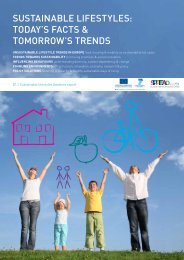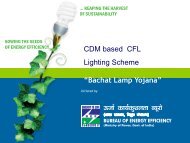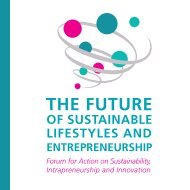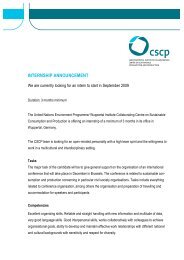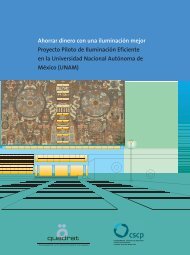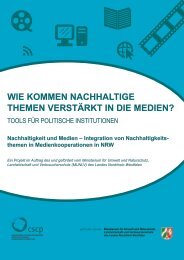integrating sustainability themes into media - Collaborating Centre ...
integrating sustainability themes into media - Collaborating Centre ...
integrating sustainability themes into media - Collaborating Centre ...
You also want an ePaper? Increase the reach of your titles
YUMPU automatically turns print PDFs into web optimized ePapers that Google loves.
Design/language/presentation of<br />
content<br />
with another being written by community members and offers users a<br />
discussion platform.<br />
e) Specials: MINIGOOD / GOOD Sheet<br />
GOOD regularly creates special <strong>media</strong> initiatives in partnership with other<br />
stakeholders. While the sponsor partners use these initiatives as marketing<br />
tools, GOOD takes advantage of the opportunity to inform and raise<br />
awareness of important social and <strong>sustainability</strong> issues. Two successful<br />
examples include MINIGOOD and The GOOD Sheet:<br />
MINIGOOD: In cooperation with The New York Times and carmaker MINI,<br />
GOOD custom created and distributed 750,000 mini-mags through<br />
subscribers of The New York Times. The mini-mag illustrated inspiring<br />
examples of individuals who try to positively change the world. Each issue<br />
contained an "If every passenger car in the US was a MINI" info graphic.<br />
The GOOD Sheet: GOOD created a series of one-page brochure-style<br />
broad-sheets for the coffee chain Starbucks. Similar to GOOD magazine’s<br />
Transparency section, each GOOD Sheet presented a graphical exploration<br />
of data on a certain social issue. During each of eleven weeks in autumn<br />
2008 a different topic relevant to the US presidential election were<br />
presented (e.g. carbon emissions, health care or education). Each issue<br />
was presented by a different sponsor (e.g. GAP, Lenovo, Google) and<br />
available for free in more than 7,000 Starbucks stores across the US.<br />
Altogether, 20 Million GOOD Sheets were distributed.<br />
Optimistic point-of-view, elegant layout, photography and illustrations, often<br />
including a dose of humour.<br />
Organisation of project Staff: 30 full-time, with half working on web and video platforms, half<br />
working on the magazine. Several guest authors and freelancers.<br />
Short description of <strong>media</strong><br />
system/legislation<br />
Business strategy: While GOOD magazine was financed on Ben<br />
Goldhirsh’s private resources at the outset, it now operates on the basis of<br />
advertising revenues. The magazine has an innovative subscription model<br />
where subscribers can choose their rate ($10, 20 or $50 a year) of which no<br />
revenue goes to GOOD but rather to one of 12 non-profit organizations.<br />
Using this model GOOD has raised over $1,000,000 for charity during its<br />
first two years and has gained significant <strong>media</strong> attention for this unusual<br />
model.<br />
Media legislation:<br />
In the US the freedom of press is guaranteed by the Constitution which<br />
means that journalistic content must neither be influenced nor censored by<br />
government.<br />
Media landscape:<br />
With more than 1,800 TV-channels, 15,000 radio stations, 10,000 daily and<br />
weekly newspapers and even more magazines, the USA is home to the<br />
world’s largest <strong>media</strong> landscape. The <strong>media</strong> market is intensely<br />
concentrated with the five largest <strong>media</strong> companies owning 90% of the<br />
market.<br />
Economic interests play a major role in shaping the information served up to





